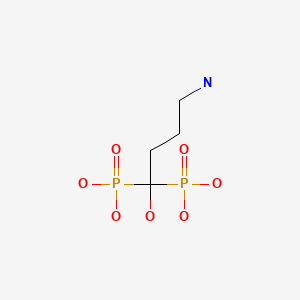Attribution Statement: LactMed is a registered trademark of the U.S. Department of Health and Human Services.
NCBI Bookshelf. A service of the National Library of Medicine, National Institutes of Health.
Drugs and Lactation Database (LactMed®) [Internet]. Bethesda (MD): National Institute of Child Health and Human Development; 2006-.
CASRN: 66376-36-1

Drug Levels and Effects
Summary of Use during Lactation
Limited evidence indicates that breastfeeding after cessation of long-term bisphosphonate treatment appears to have no adverse effects on the infant. Because no information is available on the use of alendronate during breastfeeding, an alternate drug may be preferred, especially while nursing a newborn or preterm infant. However, absorption of alendronate by a breastfed infant is unlikely. If the mother receives a bisphosphonate during pregnancy or nursing, some experts recommend monitoring the infant's serum calcium during the first 2 months postpartum.[1]
Drug Levels
Alendronate is poorly absorbed orally (average in adults 1% on an empty stomach, negligible with food and calcium), so absorption of alendronate by a breastfed infant is unlikely.
Maternal Levels. Relevant published information was not found as of the revision date.
Infant Levels. Relevant published information was not found as of the revision date.
Effects in Breastfed Infants
Because alendronate can persist in the body for years after long-term administration, the following cases may be relevant. A woman received alendronate for 6 months, then pamidronate every 4 months for 1 year prior to conception. Her infant was breastfed (extent not stated) for 3 months. The infant had mild hypocalcemia at 2 months of age, but a normal calcium level and normal long bone development at 5 months of age.[2]
Effects on Lactation and Breastmilk
Relevant published information was not found as of the revision date.
Alternate Drugs to Consider
References
- 1.
- Stathopoulos IP, Liakou CG, Katsalira A, et al. The use of bisphosphonates in women prior to or during pregnancy and lactation. Hormones. 2011;10:280–91. [PubMed: 22281884]
- 2.
- Hassen-Zrour S, Korbaa W, Bejia I, et al. Maternal and fetal outcome after long-term bisphosphonate exposure before conception. Osteoporos Int. 2010;21:709–10. [PubMed: 19533208]
Substance Identification
Substance Name
Alendronate
CAS Registry Number
66376-36-1
Disclaimer: Information presented in this database is not meant as a substitute for professional judgment. You should consult your healthcare provider for breastfeeding advice related to your particular situation. The U.S. government does not warrant or assume any liability or responsibility for the accuracy or completeness of the information on this Site.
- User and Medical Advice Disclaimer
- Drugs and Lactation Database (LactMed) - Record Format
- LactMed - Database Creation and Peer Review Process
- Fact Sheet. Drugs and Lactation Database (LactMed)
- Drugs and Lactation Database (LactMed) - Glossary
- LactMed Selected References
- Drugs and Lactation Database (LactMed) - About Dietary Supplements
- Breastfeeding Links
- PubChem SubstanceRelated PubChem Substances
- PubMedLinks to PubMed
- Review Pamidronate.[Drugs and Lactation Database (...]Review Pamidronate.. Drugs and Lactation Database (LactMed®). 2006
- Review Etidronate.[Drugs and Lactation Database (...]Review Etidronate.. Drugs and Lactation Database (LactMed®). 2006
- Review Risedronate.[Drugs and Lactation Database (...]Review Risedronate.. Drugs and Lactation Database (LactMed®). 2006
- Review Tiludronate.[Drugs and Lactation Database (...]Review Tiludronate.. Drugs and Lactation Database (LactMed®). 2006
- Review Ioxaglate.[Drugs and Lactation Database (...]Review Ioxaglate.. Drugs and Lactation Database (LactMed®). 2006
- Alendronate - Drugs and Lactation Database (LactMed®)Alendronate - Drugs and Lactation Database (LactMed®)
Your browsing activity is empty.
Activity recording is turned off.
See more...
